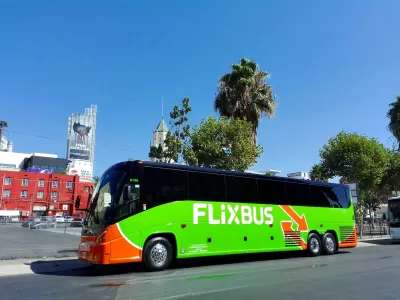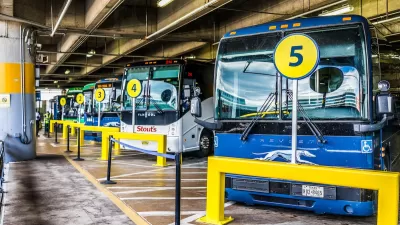Passengers continue to rely on intercity bus lines, even as cities shutter bus terminals and bus companies restructure to avoid financial failure.

Despite operators’ financial struggles and the closure of dozens of bus terminals around the country, intercity bus ridership is growing in the United States, prompting bus companies to expand their fleets, reveals a report from the Chaddick Institute. “Greyhound acquired 60 motor coaches last year; Trailways, 30; and Peter Pan, 15. The Motorcoach Builders Survey for the third quarter of 2024 saw sales of new coaches up over 15% from the same period in the previous year.”
According to a Smart Cities Dive piece by Dan Zukowski, intercity buses provided almost 50 million riders in 2023, and ridership could grow by as much as 4 percent this year — higher than growth in air travel. Colorado’s Bustang line carried almost 280,000 riders in 2023. Other state-supported bus services are available in North Carolina, Virginia, and Washington,and Maine launched a new intercity service last year.
As Zukowski notes, “State services like these are made possible by the Federal Transit Administration’s formula grants for rural areas program, also known as Section 5311.”
However, the report warns that closures of terminals have slowed ridership recovery in rural and secondary routes, and some urban bus terminals are on the chopping block or have already closed down.
FULL STORY: Intercity bus service on the upswing

Alabama: Trump Terminates Settlements for Black Communities Harmed By Raw Sewage
Trump deemed the landmark civil rights agreement “illegal DEI and environmental justice policy.”

Planetizen Federal Action Tracker
A weekly monitor of how Trump’s orders and actions are impacting planners and planning in America.

The 120 Year Old Tiny Home Villages That Sheltered San Francisco’s Earthquake Refugees
More than a century ago, San Francisco mobilized to house thousands of residents displaced by the 1906 earthquake. Could their strategy offer a model for the present?

In Both Crashes and Crime, Public Transportation is Far Safer than Driving
Contrary to popular assumptions, public transportation has far lower crash and crime rates than automobile travel. For safer communities, improve and encourage transit travel.

Report: Zoning Reforms Should Complement Nashville’s Ambitious Transit Plan
Without reform, restrictive zoning codes will limit the impact of the city’s planned transit expansion and could exclude some of the residents who depend on transit the most.

Judge Orders Release of Frozen IRA, IIJA Funding
The decision is a victory for environmental groups who charged that freezing funds for critical infrastructure and disaster response programs caused “real and irreparable harm” to communities.
Urban Design for Planners 1: Software Tools
This six-course series explores essential urban design concepts using open source software and equips planners with the tools they need to participate fully in the urban design process.
Planning for Universal Design
Learn the tools for implementing Universal Design in planning regulations.
Clanton & Associates, Inc.
Jessamine County Fiscal Court
Institute for Housing and Urban Development Studies (IHS)
City of Grandview
Harvard GSD Executive Education
Toledo-Lucas County Plan Commissions
Salt Lake City
NYU Wagner Graduate School of Public Service





























